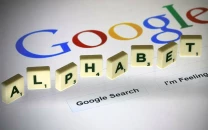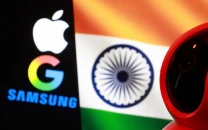Startup Pi introduces wireless charging through magnetic waves
Pi chargers, about the size of a small table vase, operate on standard charging technology used in Apple smartphones

A Pi device that can charge smartphones wirelessly from about a foot away, even if they are being used, is shown off at a TechCrunch Disrupt startup conference in San Francisco on September 18, 2017 Pi, the world's first wireless charger that does away with the need to lay devices on charging mats, operates on standard charning technology used in Apple or Android smartphones designed to be powered up wirelessly. PHOTO: AFP
Pi chargers, about the size of a small table vase, operate on standard charging technology used in Apple or Android smartphones designed to be powered up wirelessly.
But instead of cords or mats, the conical creation charges smartphones with magnetic waves.
Magnetic fields are an ideal way to safely send energy to portable electronics, said Pi chief technology officer Lixin Shi, who co-created the charger with John MacDonald.
Starbucks to update its charging pads to support the iPhone X
The trick was bending magnetic waves to find smartphones, the co-founders said during a presentation for an AFP journalist at the TechCrunch Disrupt startup scrum in San Francisco.
"The hard part was figuring out how to make magnetic charging more flexible, multi-device and extend its useful range," Shi said.
"It took us over a year to complete the mathematical proof that makes it all possible."
The pair figured out how to shape the magnetic field so energy could be beamed to smartphones placed or in use within a foot of a Pi.
Shi and MacDonald were graduate students at the Massachusetts Institute of Technology when they met and began to collaborate on the project about 3.5 years ago. Both have since graduated from university.
Pi's magnetic fields are relatively weak, far less than the levels used for medical imaging, but allow devices to be charged at "full speed," according to MacDonald.
A combination of smartphones and tablets could wirelessly charge on a desk if a Pi were placed near people working together.
Pi set up shop in the Silicon Valley city of San Bruno, and the co-founders said they raised $3.5 million in a seed funding round lead by SoftTech VC managing partner Jean-Francois Clavier.
With a $999 price tag, here's what Twitter thought of the new iPhone X
MacDonald promised that Pi devices would begin shipping next year and be priced "well below $200."
Apple this month unveiled three new iPhone models, including a 10th-anniversary edition iPhone X, all of which featured wireless charging.
The company said it will come to market with AirPower charging mats sized to accommodate an iPhone, Apple Watch and an AirPods earpiece case.



















COMMENTS
Comments are moderated and generally will be posted if they are on-topic and not abusive.
For more information, please see our Comments FAQ